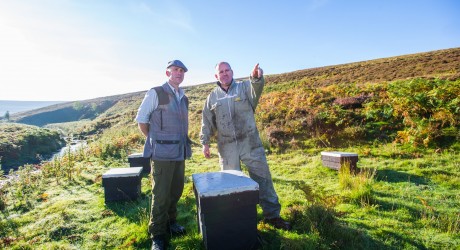BEES and honey producers are thriving across parts of Scotland thanks to a helping hand from one of the nation’s most iconic birds – the red grouse.
Despite long-held concerns over a decline in the number of bees across the country – not helped by this summer’s inclement weather – rural estates are reporting a proliferation in bees present on moorland as they access Scotland’s iconic heather, something welcomed by the Scottish Beekeepers Association.
Says a spokesperson: “Heather moorland is most prominent on grouse managed moorland, where heather is a central part of the red grouse’s diet. Around 75 per cent of the world’s heather is in the UK, with the majority of that on moors in Scotland.
“However, it’s not only the red grouse that makes use of the heather.
“Across estates in Tayside and Angus Glens, beekeepers are positioning their hives on estates – in partnership with estate owners and gamekeepers – to increase the production of heather honey, fast becoming a famed Scottish food product to rival the acclaimed manuka honey.”
And in the Lammermuir Hills, there is a buzz around many of the region’s sporting estates that have been hosting honeybees producing heather honey that is in international demand.
On two of the region’s estates – Hopes Estate and Mayshiel Estate – hives are placed every August and September. The honeybees access the heather, producing a unique type of honey that contains three sugars instead of the standard two.
At this time of year, the hives are moved from the estate in order for honey production to begin, which has already begun to hit shelves at home and abroad.
Ian Elliott, head gamekeeper at Hopes Estate, and part of the Lammermuirs Moorland Group, said: “The moorland heather, which is maintained to the highest standard as part of the integrated management of the estate, is favoured by beekeepers – due to its rotational renewal.
“The heather is burned in strips in accordance with the Muirburn Code, which leads to its regeneration and more vigourous flowering and pollination which is perfect for the honeybees to access.
“We have hosted hives on the moor for decades and it adds another layer of biodiversity to the estate.
“We are delighted to work in partnership with local honey producers and it is exciting from our point of view that we can play a small role in creating a Scottish food product that is in demand around the world.”
One of the businesses working with estates in the Lammermuir Hills is Hood’s Honey.
For Stuart Hood, owner of Hood’s Honey, the partnership is vital to the success of his business.
Stuart said: “We have been delighted to work in partnership with estates in the Lammermuir Hills for generations. My father worked with the estates in decades gone by and I’m pleased we have been able to continue this.
“The estates have always been very welcoming to us and without the access to the heather then our business would not be thriving in the manner that it is.
“We produce three types of honey per annum but the heather honey is our crucial crop of the year.
“We move all of our hives, each containing around 65 to 75,000 bees, onto the estates where the bees can feed off the finest of heather that is in full bloom.
“That allows us to produce honey that has a unique flavour, and captures the taste of the peaty soil in the region. Without the work of the gamekeepers, we wouldn’t be able to achieve this.
“It is often said that grouse shooting estates are inaccessible or are solely there for the grouse. It certainly isn’t the case in my experience, and the gamekeepers work hard to ensure that everything can flourish on the estates – including the heather for our bees.
“The honey is in international demand, and this week we’ve had new requests from Pennsylvania for the product.
“Demand outstrips supply, but thanks to our work with the estates we are able to produce a product that is unique to Scotland. The hives are now ready to come off the estates and we’ll soon by seeing the product of the bees’ labour on the shelves.
“Despite the perception that estates are set apart from the community, nothing could be further from the truth for us.
“Everyone from the owners to gamekeepers to other estate staff are keen to see our business, and others in the community, flourish.”
That view is echoed by Gavin Ramsay, the Scottish Beekeepers Association’s Science Officer.
Gavin said: “Beekeepers are working with estates across Scotland, and find them extremely welcoming to the work we do and to hives being placed on moorland.
“At a time of year when bees can struggle to find sufficient forage elsewhere, moorland provides the perfect location for bees.
“There is an undoubted health benefit for the bees arising from well-provisioned colonies bustling with young bees raised on managed heather moors.
“That contrasts with colonies left in the arable lowlands at sites where there is little forage in August most years and where bees may need fed to thrive.
“There is an appreciation in the beekeeping community of those who committed to preserving a habitat such as heather moorland that can be at risk in other areas due to overgrazing and climate change.
“It also helps us to continue and preserve the old tradition of transhumance – moving your stock to the hills for the late summer forage – which is something that beekeepers value highly.”
ENDS
Picture caption: Ian Elliott, head gamekeeper on the Hopes Estate, with beekeeper, Stuart Hood, who keeps a number of hives on the Hopes Estate near Duns.
For further information:
Gary McQueen
Media House
T: 0141 220 6040
About the Gift of Grouse
The Gift of Grouse is a major new campaign being run by the Scottish Moorland Group designed to highlight the benefits of grouse moors to Scotland.
A year-long initiative, the Gift of Grouse focuses on four key pillars – tourism and leisure, employment, environment and conservation, and accessibility – to demonstrate the difference that grouse shooting makes to both fragile countryside communities and to wider Scotland.
For more information, visit www.giftofgrouse.com
MEDIA RELEASE issued by Media House International. You too can post your story ideas for journalists (aka press or media releases), on allmediascotland.com. Email here for more information.
Check out twitter.com/nonstopstories for your very own media releases feed…
To catch up on all the media releases recently posted on to allmediascotland.com, you need only click the link icon that you see towards the bottom right of our two media release ‘gateway boxes’.
 It’s this icon, here. It’s your route straight into the rich archive.
It’s this icon, here. It’s your route straight into the rich archive.
—
Media House International contact details…
Contact: Gary McQueen
Phone: 0141 220 6040
Email: gary@mediahouse.co.uk
Website: http://www.mediahouse.co.uk







